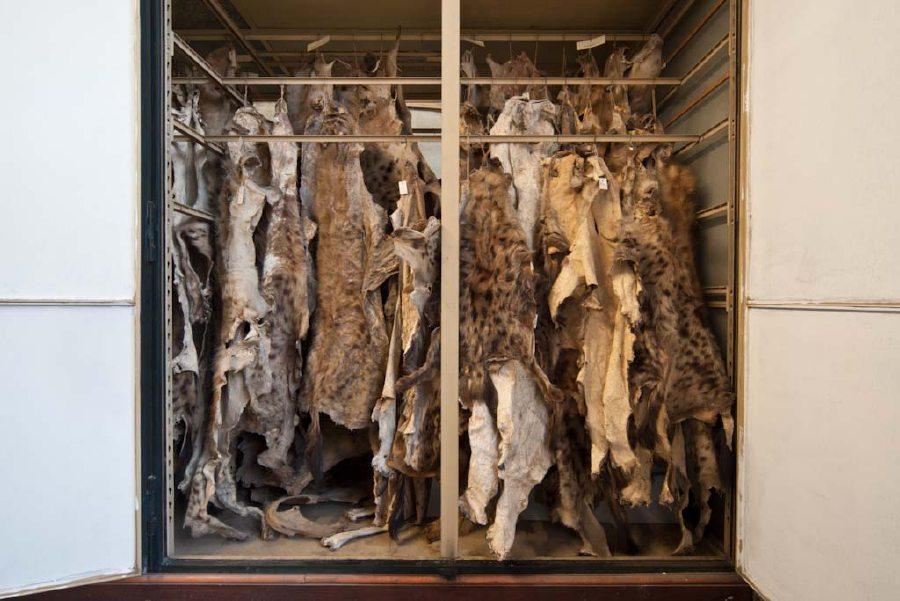The Expansion of the Mammal Collection around 1900
The Center of the Humanities of Nature at the Museum für Naturkunde Berlin (MfN), has during the last years increasingly devoted its attention to the colonial history of the museum and its collections. The project "Colonial Provenances of Nature. The expansion of the mammal collection around 1900" builds up from this work. It examines the history of the MfN's mammal collection in the decades between 1880 and 1920. During this period, the collection expanded remarkably in terms of quantity and uniqueness of the material available. This increase was made possible through a context of imperial expansion which was employed by curator Paul Matschie (1861-1926) to intensify scientific networks and implement a colonial research agenda.
The aim of the project is firstly to investigate the interplay of the actors involved by reconstructing the relevant historical framework conditions, the driving interests and motivations as well as the networks, and to describe the institutionalisation of colonial collecting at the MfN. Secondly, the project contributes to an interdisciplinary history of colonial collecting. It integrates zoology into the closely connected history of ethnological, biological-anthropological and other natural history collections in Berlin and thus takes into account the finding that during the period under investigation, collecting was almost always interdisciplinary. Thirdly, by making the provenance of these collections more visible the project aims to establish and deepen cooperation with the communities of interest.
The project is funded by the German Lost Art Foundation. The final report will be published online here and be accessible in the Proveana database.
A central focus of the project was the assessment of shipments from collecting localities in the colonial space of German “Kamerun.” This work resulted in the publication of Cameroon in Berlin, which gives a historical overview of cataloguing practices and collection management. This is followed by Part I, which lists over 100 archival folders and 400 shipments from German “Kamerun”; and Part II, which publishes the report of the assessment done by Cameroonian researcher Paul Taku Bisong on mammal type-specimens in 2022 (main findings published in 2023).
Other outputs of the project include:
Bisong, Paul Taku; Dunlop, Jason, and Madruga, Catarina (2023) ‘Mammalian type material from Cameroon in the Museum für Naturkunde Berlin’, Zoosystematics and Evolution, 99(2), pp. 503–517. Available at: https://doi.org/10.3897/zse.99.110878.
Dubova, Alona (2024) ‘Leerstellen im Archiv: Zur Fotografie eines toten Bartfisches’, in Sophia Gräfe and Julia Bärnighausen (Eds.) Bilder der Natur. Objektgeschichten aus den Bild- und Schriftgutsammlungen der Historischen Arbeitsstelle. Available at: https://www.museumfuernaturkunde.berlin/de/leerstellen-im-archiv-zur-fotografie-eines-toten-bartfisches.
Kaiser und Madruga (in press, 2024) Tagging Objects from Colonial Contexts. A Decision Tree for Natural History Collections. Magdeburg: Deutsches Zentrum Kulturgutverluste (Working Paper, 7). Available at: https://kulturgutverluste.de/mediathek/publikationen/working-paper.
Kiourtidis, Polina and Wüste, Hanna (2024) ‘Nach dem Leben gezeichnet. Illustration einer Mendesantilope von Anna Held’, in Sophia Gräfe und Julia Bärnighausen (Eds.) Bilder der Natur. Objektgeschichten aus den Bild- und Schriftgutsammlungen der Historischen Arbeitsstelle. Available at: https://www.museumfuernaturkunde.berlin/de/nach-dem-leben-gezeichnet.-illustration-einer-mendesantilope-von-anna-held.
Madruga, Catarina; Antonites, Anita and Ansidei, Daniele. (in preparation, 2025) ‘Elephant from the Trenches. Multiple itineraries of an anonymous elephant,’ Humanimalia. Special Issue “Elephant (research) Routes” edited by Marianna Szczygielska and Violette Pouillard.
Madruga (2022) ‘Die Deutsch-Koloniale Jagdausstellung. Die Zurschaustellung wilder Tiere als koloniale Aneignung’ In Animals as Objectshttps://animalsasobjects.org/, edited by Ina Heumann und Tahani Nadim. Available at: https://doi.naturkundemuseum.berlin/data/64y2-m311/74.
Madruga (2022) ‘Von einer Karawane gekauft. Geschichten, die uns Tierschädel erzählen. ’ In Animals as Objects https://animalsasobjects.org/, edited by Ina Heumann und Tahani Nadim. Available at: https://doi.naturkundemuseum.berlin/data/64y2-m311/58.
Madruga, Catarina (2023) ‘Review: Mobile Museums. Collections in Circulation, by Felix Driver, Mark Nesbitt, and Caroline Cornish, eds.’, Nuncius / Istituto e museo di storia della scienza, 38(3): 744–746. Available at: https://www.academia.edu/116378293/Madruga_2023_Review_for_Nuncius.
Madruga, Catarina (Ed.) (2024) Cameroon in Berlin. I: Archives and Catalogues, II: Type-Collection.
Madruga (in preparation) ‘Collecting borders. Meanings and Implications of Scientific Locality.’
Mering, Sabine von et al. (2024) ‘Sharing data, caring for collections. Open data on collection agents affiliated with the Museum für Naturkunde Berlin’, Research Ideas and Outcomes, 10, p. e118851. Available at: https://doi.org/10.3897/rio.10.e118851.
Wagner, Sarah and Dubova, Alona (2024) ‘Auf dem Weg zu sensiblen Erschliessungsmodellen am Museum für Naturkunde Berlin - Chancen und Grenzen des Digitalen’, in K. Günther und S. Alschner (Eds.) Sammlungsforschung im digitalen Zeitalter. Chancen, Herausforderungen und Grenzen. Göttingen: Wallstein Verlag (Kulturen des Sammelns. Akteure, Objekte, Medien). Available at: https://manifold.hab.de/projects/sammlungsforschung-im-digitalen-zeitalter.
